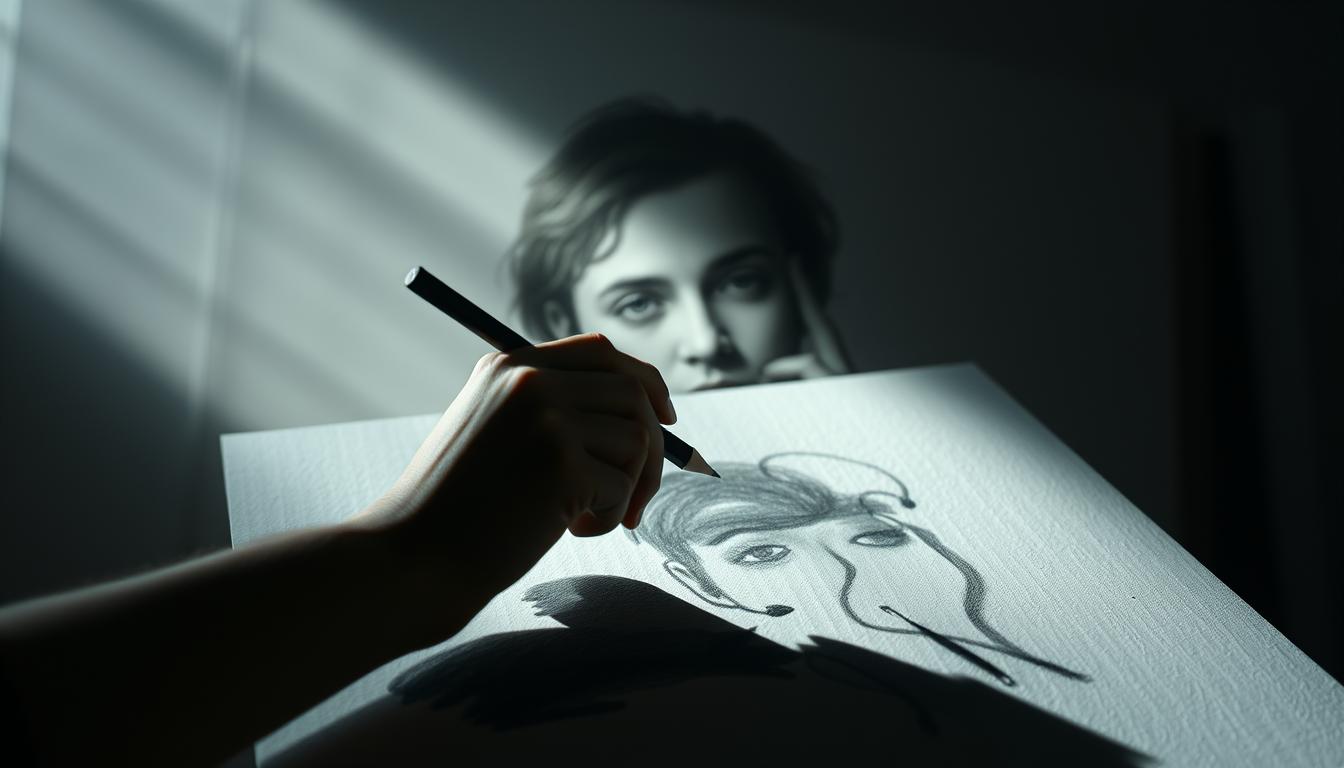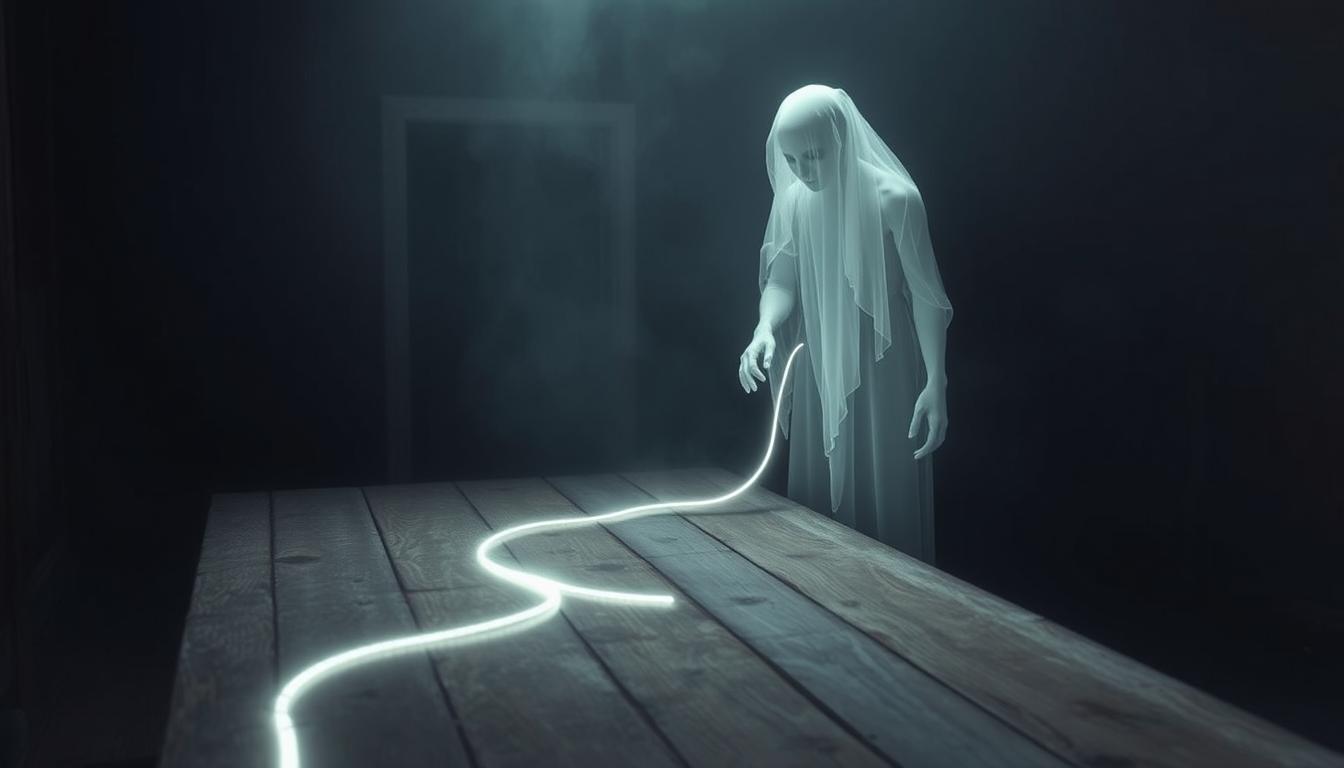Have you ever wondered if a small rehearsal could make your lines bolder?
Ghosting is an invisible rehearsal done just above the page to plan a mark before contact. It helps you map each start and end point, rehearse the whole motion with your arm, then commit to one clean line.
Begin with planning: pick the exact points your mark must hit and rotate the paper to suit your stroke. Prepare by aligning posture and practicing the motion above the surface.
Execution asks for a single confident stroke. Expect three typical outcomes: smooth but off, smooth with overshoot, or smooth and precise. Simple fixes — like lifting at the end or drawing from the shoulder — cut wobble and build confidence.

We’ll walk through a clear process, practice drills, and troubleshooting. For a structured exercise, check the guided lesson at ghosted lines practice.
Key Takeaways
- Ghosting is an above-surface rehearsal that improves mark placement and reduces hesitation.
- Follow planning, preparation, and execution to turn rehearsal into one decisive stroke.
- Rotate the page and use shoulder motion to avoid wobbles and overshoot.
- Daily drills of points and lines build muscle memory for longer curves and ellipses.
- Small rehearsals directly boost confidence and cleaner final lines.
What is ghosting in art? Definition, purpose, and when to use it
Simulating the path just above the drawing surface primes your muscles to commit to a single clean pass.
Clear definition: the “invisible” practice stroke above the surface
Ghosting means rehearsing a stroke by moving your pen or pencil from a marked start point to an end point while hovering above the paper, then making one confident pass. This small rehearsal maps the route so your hand already knows the intended path before contact with the surface.
Why artists ghost: confidence, accuracy, and cleaner lines
Artists use this approach to separate planning from doing. A few hover passes reduce hesitation and let your arm follow the practiced motion.
- Purpose: align a goal—connect two points or define an edge—so you avoid messy marks.
- Feel: the motion should be smooth and natural, matching the path you practiced just above the paper.
- Benefits: fewer wobbles, cleaner lines, and better control when drawing from the shoulder.
- When to use: long straight lines, ellipses, tight curves, perspective guides, or any stroke needing precision.
- Tip: rotate the page, mark small dots to anchor the move, and try lifting the pen as you reach the end to avoid overshoot.
How to ghost your lines step by step: plan, prepare, execute
Set a clear goal for the line, then train your arm to follow that path before touching the surface.
Planning the mark
Step 1 — Plan: Mark the start and end point and decide why the line matters. Rotate the page until the motion feels natural for your strongest direction.
Preparation and rehearsed passes
Step 2 — Prepare: Sit upright, free your shoulder, and hold the pen so the elbow and arm move together. Hover the nib above the surface and run two to four faithful passes to build short-term muscle memory.
Execution with confidence
Step 3 — Execute: Place the pen at the start and pull one smooth stroke using your arm. Keep the wrist relaxed and avoid slowing mid-line. If you overshoot, lift the pen the instant you hit the end point.
- Match the speed of your rehearsals to the final stroke for transferable movements.
- Apply this way for straight lines, ellipses, circles, and C-curves.
- If the trajectory fails, review the plan and repeat the steps rather than adding marks.

| Step | Main Action | Quick Tip |
|---|---|---|
| Plan | Mark start/end points and set the goal | Rotate page to favor your strongest arm motion |
| Prepare | Practice passes with the pen above the surface | Limit to 2–4 passes; match final stroke speed |
| Execute | Commit to one smooth stroke driven by the shoulder | Lift at the end point to stop cleanly if needed |
Practice that builds muscle memory: drills, posture, and using your whole arm
Short, focused drills train your arm to move reliably so marks land where you expect.
Daily drills: Fill a page with points and connect them with straight lines using the ghosting method. Add ellipses, circles, and C-curves freehand. Start each set with a few hover passes, then commit to single, confident strokes.
Posture and movement: Sit or stand so your shoulder and elbow can lead. Let the wrist relax. Driving strokes from the arm stabilizes the motion and shrinks wobble.
Finding your rhythm: Repeat rehearsed passes until the movement feels smooth. Returns drop after a few passes, so focus on smoothness first, then accuracy. Use short timed sessions—10–15 minutes—so practice stays focused and you avoid fatigue.
- Vary line lengths and rotate the page to train adaptability.
- Track progress by noting hit rates between points; aim for smoother strokes, then precision.
- Apply this across your drawing course so the method becomes habitual and boosts confidence over time.
Troubleshooting your lines: common mistakes and quick fixes
A quick hover can tell you if a planned stroke will track clean or break into a wobble.
Wobbly or arcing marks usually come from hesitation or using the wrist too much. Commit to a confident stroke and drive the motion from your shoulder. If a curve bends the wrong way, arc slightly the opposite direction to cancel the bias.
Overshoot and undershoot are normal. For overshoot, lift the pen the instant you hit the end point; it stops cleaner than slowing down. If you undershoot, avoid braking late — keep steady speed and trust the rehearsal passes.

Not the same as animation ghosting. Drawing ghosting is a rehearsal above the page. Animation ghosting refers to motion trails or visual artifacts on screen. That broadcast use and safety measures are unrelated to drawing practice.
| Problem | Likely Cause | Quick Fix |
|---|---|---|
| Wobbly line | Hesitation or wrist-led motion | Use shoulder drive; rehearse 2–4 passes and commit |
| Arcing line | Wrist bias or limited range | Counter-arc slightly; rotate the page |
| Overshoot / Undershoot | Poor end control or late braking | Lift the pen at the point; keep steady speed |
| Repeated corrections | Overworking a mistake | Analyze rehearsal, redraw cleanly from plan |
- Keep using small dots as a visual point to anchor your path.
- Rotate the paper so the stroke follows your strongest motion.
- Recall: smooth strokes that miss a bit help more than shaky ones that hit the spot.
Conclusion
A simple rehearsal above the page turns uncertain marks into confident strokes. This reliable technique—often called ghosting—distills markmaking into plan, prepare, and execute. Use it to make each line deliberate and steady.
Spend short blocks of time on focused practice. Treat the step-by-step routine as part of any drawing course or home study. Start by connecting points with single-pass strokes, then add ellipses, circles, and C-curves.
Over weeks, steady time beats long sessions. Shift the page, draw from your shoulder, and lift at the end point to stop overshoot. Add this simple technique to your next session and watch one small habit change how your lines perform.
FAQ
What does ghosting mean as a drawing technique?
It refers to the rehearsal stroke artists make above the paper before touching the tip to the surface. This invisible practice movement helps set a clear start and end point so the final line is cleaner and more confident.
Why do artists rehearse strokes before drawing?
Rehearsing builds accuracy and reduces hesitation. By planning the mark and moving the pen along the intended path, artists improve control and create smoother, straighter lines with fewer corrections.
How do you plan a line before you draw it?
Define the line’s goal: where it starts, where it finishes, and the desired curvature or angle. Visualize the motion, then perform a few ghost passes to lock in the trajectory before committing to ink or pen on the paper.
What’s the proper way to perform ghosting passes?
Hold the pen above the page and trace the intended motion using your whole arm. Keep the tip clear of the surface and move smoothly from start to end points a few times until the motion feels natural and steady.
How should I execute the final stroke?
Commit to a single confident motion, using the same arm movement practiced during ghosting. Rotate the page if needed so your strongest motion path aligns with the line direction, then draw one decisive stroke.
What daily drills help improve ghosting and line quality?
Practice straight lines between set points, ellipses, circles, and C-curves. Do controlled repetitions from the shoulder and elbow, not just the wrist, to build muscle memory and consistency over time.
How does posture affect line control?
Good posture frees your shoulder and elbow to move smoothly. Sit with a relaxed arm and stable forearm anchor, allowing longer, steadier motions that reduce wobbles and unwanted arcs.
How many ghosting passes should I do before drawing the final line?
It depends on confidence. Two to five focused passes usually suffice. Spend more time when learning new shapes, fewer when you feel steady. Quality matters more than quantity.
What causes wobbly or arcing lines and how do I fix them?
Wobble often comes from relying on the wrist or tension. Fix it by drawing from the shoulder, slowing the motion, and using ghost passes to rehearse a straighter path. Rotate the paper to align with your natural arm movement.
How do I avoid overshooting or undershooting end points?
Practice lifting the pen just after the intended end point and rehearse stopping the motion. Set clear visual endpoints and do shorter, controlled passes that finish exactly where you want.
Is this the same as motion-blur ghosting used in animation?
No. The rehearsal method is a single-stroke planning technique to improve line accuracy. Animation ghosting shows multiple positions for motion effect; drawing ghosting is a preparatory physical practice.
What tools or surfaces work best for practicing ghost lines?
Any pen or pencil and a smooth paper surface work fine. Felt-tip pens, technical pens, or fountain pens highlight mistakes clearly, making them useful for focused practice sessions.
How long before I see improvement using ghosting techniques?
With short daily drills, most people notice steadier strokes within a few weeks. Consistent practice builds muscle memory and confidence, improving line quality and reducing reliance on corrections.




Leave a comment
This site is protected by hCaptcha and the hCaptcha Privacy Policy and Terms of Service apply.